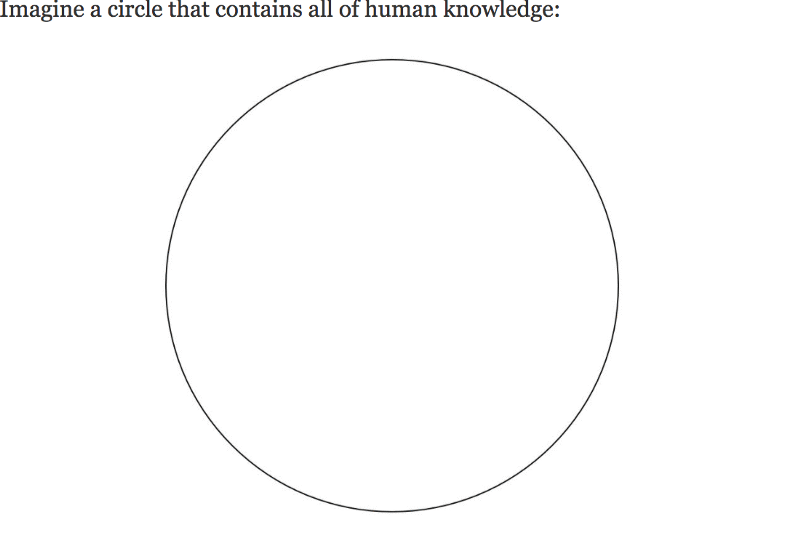I love the idea of the adjacent possible. It’s this idea that at any point in time, the future of technology is just a recombination of existing ideas and inventions. Steven Johnson describes the adjacent possible as
“a kind of shadow future, hovering on the edges of the present state of things, a map of all the ways in which the present can reinvent itself. In the case of prebiotic chemistry, the adjacent possible defines all those molecular reactions that were directly achievable in the primordial soup. Sunflowers and mosquitoes and brains existed outside that circle of possibility.”
In other words, the inventions of tomorrow are constrained by the ideas and technology of today. It reminds me of this illustration of PhDs:

Working in venture capital, I see the adjacent possible influence the startup ideas we get most excited about.
Partly this is a question of timing. Does existing technology and user behavior support a company’s imminent existence and rapid growth or will we have to wait a bunch of years for the technology, market, or consumer behavior to catch up? Take Fitbit, founded in May 2007, the month before the iPhone’s debut. They were well timed to reach scale a few years later as smartphone penetration took off. Had Fitbit launched 5 years prior, before the app store and cheap accelerometers it may have languished as a niche product. In the last few years, self driving cars have also entered the adjacent possible due to advancements in SLAM, computer vision, and communities of people working at the frontier. There still seems to be disagreement over when we’ll achieve “drive you anywhere anytime” (level 5) autonomy but “drive you to a constrained set of places in good weather” (level 4) autonomy certainly seems imminent.
Investing in the adjacent possible also helps maximize value creation. To over generalize, incumbents dominate markets and make it hard for startups to compete. But, if a market is in flux with new technology and behavior, the likelier it is that incumbents can be disrupted. While there’s market opportunity if you have only new tech (say, you’ve discovered an incrementally better solar panel) the most value creation tends to occur when market changes happen simultaneously: when new technology drives new behavior and the creation of new platforms all at once. This certainly happened over the last decade with social media. Rapidly advancing mobile technology spurred new behaviors around both content production and consumption and gave us behemoth platforms like Facebook. In my view this is happening today in the connected devices space and is beginning to happen in virtual reality. New tech is once again nudging users to change their behavior, be open to new product discovery, and reject previous brand affiliations.
The catch here is that it’s often hard to know whether you’re working in the imminent future or the far future. Is this startup idea within today’s adjacent possible or is it still in the distant world of flying cars and interplanetary travel? This is often surprisingly hard to figure out. I’m sure Webvan, the $800 million dollar grocery delivery bust of the internet bubble seemed within the adjacent possible at the time. The technology was certainly there. Turns out that people weren’t yet open to changing their grocery habits. Or, take augmented reality startup Magic Leap. It strikes me that they’re working at the edge of too many frontiers. They need to figure out new technology, new interaction paradigms, and new kinds of content all at once.
There’s a great Paul Graham essay that talks about how to get startup ideas. The central advice is “Live in the future and build what seems interesting”. This is good career advice, especially if you have a 20–30 year time horizon. As an investor with a 5–10 year time horizon I’d modify that a bit to say: live and work in the adjacent possible. It’s hard to know when the future converges with the present.
Notes/Misc concepts:
- Many of these ideas are paraphrased from Steven Johnson’s fantastic books How We Got to Now and Where Good Ideas Come From.
- The idea of the adjacent possible isn’t all about technological progress. It applies to culture and behavior too. Many of today’s TV shows (Silicon Valley, Black Mirror) would have looked like bizarre performance art to viewers 30 years ago. Social media apps like Secret and Snapchat were direct reactions to the searchable, public communities prior.
- We have this myth in society of lone inventors (or startup founders). The truth is that many celebrated discoveries actually happened simultaneously and independently. Newton was not the only one to discover calculus. Darwin was not the only one to discover evolution. While copycats do exist, startups also experience the phenomenon of simultaneous and independent discovery. If you’re working at the fringe, expect others to be as well. This is why competitive moats are so important to VCs.
Bolt invests at the intersection of the digital and physical world.